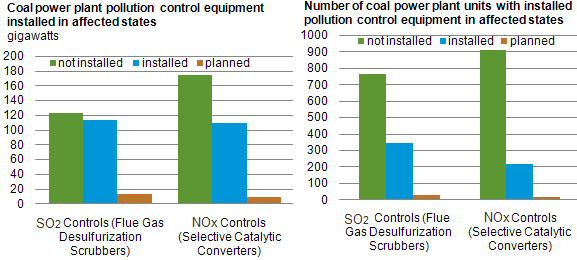
Cross State Air Pollution Rule requires emissions reductions from Eastern U.S. powerplants

On July 7, 2011, the Environmental Protection Agency (EPA) released the final version of the Cross-State Air Pollution Rule (CSAPR). The CSAPR is intended to reduce emissions of sulfur dioxide (SO2) and nitrogen oxides (NOx) from power plants in the eastern half of the United States by imposing state-level caps on emissions and facilitating a limited interstate cap-and-trade program.
There are several possible strategies for reducing SO2 and NOx emissions from coal-fired power plants: plant owners can use lower sulfur coal in their boilers, run the plants with higher emissions less often, retire plants without emissions controls and run other plants, or install emissions control equipment—primarily, flue gas desulfurization units (FGD, or scrubber) for SO2 and selective catalytic reduction (SCR) units for NOx.
The CSAPR's SO2 limits apply to 23 states. Total coal-fired electric generating capacity in these states is 250 GW, or 76% of total national coal capacity, including end-use generators. Approximately 45% of these plants already had FGD scrubbers in 2009, with installations planned for an additional 5%. FGD scrubbers remove SO2 from post-combustion flue gas through the use of an alkaline solution.
The CSAPR has two NOx limits, one for annual emissions and one for summer emissions. Twenty-six states fall under one or both of these categories. Total coal-fired electric generating capacity in these states is 276 GW, or 84% of the national total. Approximately 42% of these plants have SCRs installed and an additional 4% are currently installing them. SCRs use a catalyst, typically ammonia or urea, to react with the flue gas to reduce NOX to nitrogen and water.
Since adding FGDs and SCRs are significant capital investments, economies of scale result from installing them on larger units. In the case of FGD scrubbers, while the capacities of scrubbed and unscrubbed coal plants are about the same, the number of unscrubbed coal plants is significantly greater.
The CSAPR is intended to replace the Clean Air Interstate Rule (CAIR), which was vacated by the District of Columbia Circuit Court of Appeals ruling in 2008. The rule is scheduled to take effect in 2012.
In the Annual Energy Outlook 2011, EIA analyzed several alternative scenarios focusing on the impact of possible future air emissions regulations on the power sector.